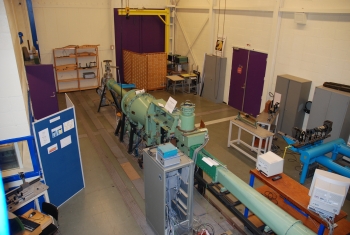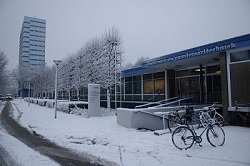ST-15 Supersonic windtunnel
The ST-15 wind tunnel was the first supersonic wind tunnel to be operated by the Faculty of Aerospace Engineering. Of early design, it is not equipped with a flexible-wall nozzle; interchangeable sets of liners are used to obtain Mach numbers of either 1.5, 2, 2.5 or 3 in a 15 cm x 15 cm test section. Due to its long running time - a total running time of the order of 18 minutes is available before recharging the pressure vessel is required - the wind tunnel is still very much in demand for tests involving flow visualization or detailed exploration of the flow field. The possibility of using specially adapted liners has proved to be an advantage for particular tests.
For instance, asymmetric nozzle blocks have been used to study the interaction of embedded shock waves with the boundary layer over a curved surface. In this set-up, the lower nozzle block is shaped to generate supercritical flow simulating local flow conditions over an airfoil, while the upper block is contoured according to the calculated shape of a streamline in order not to interfere with the development of the flow field. Automatic control of a downstream sonic throat maintains the desired Mach number and position of the shock wave. A mechanism is provided for traversing probes in three directions through the test section. Comparatively large windows (250 mm diameter) provide a large field of view for non-intrusive optical measurements.
Typical research topics
- Investigation of new rocket propulsion techniques (plug nozzle engine)
- Backward facing step flow for the investigation of roughness induced boundary layer transition and scramjet injectors
- Development of advanced heat transfer techniques
- Investigation of tracer particle characteristics for Particle Image Velocimetry (PIV)

Overview of ST-15 wind tunnel
Location:

High Speed Lab
- +31 15 2789670
-
Kluyverweg 2
2629 HT Delft